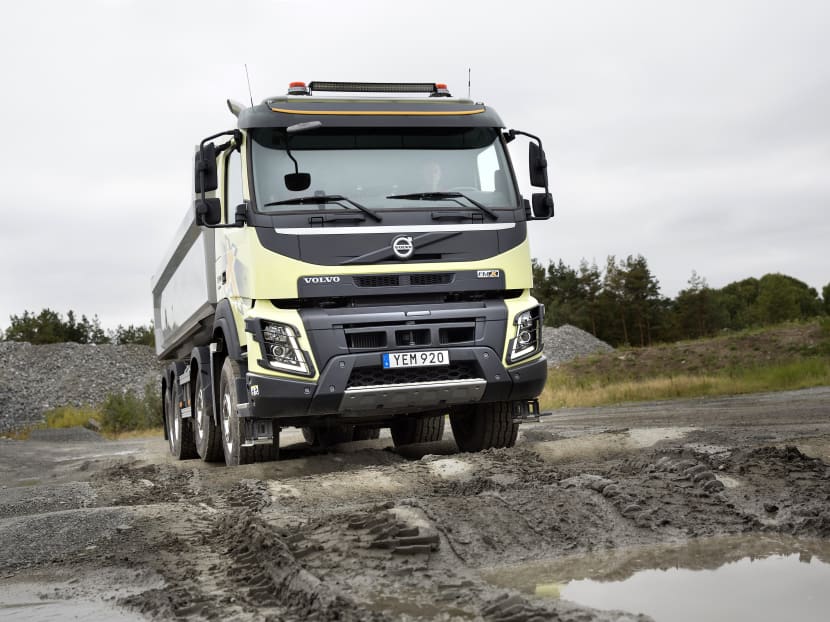Drive like a trucker: Road lessons from those hauling big rigs
GOTHENBURG (Sweden) — Considering that trucks take up more road space than anything else with wheels, few of us give these drivers a second thought about the skill that’s needed to keep their rigs out of harm’s way. Adding to the challenge of being able to drive with precision, fuel efficient driving is another skill set they possess that not many motorists are aware of.

A truck negotiates the off-road terrain at the Volvo Trucks Fuelwatch Challenge in Gothenburg. There are several lessons car drivers can learn from good truck-driving, said Volvo's Per-Bruun Hansen, the head referee of the Fuelwatch Challenge. Photo: Sheldon Trollope
GOTHENBURG (Sweden) — Considering that trucks take up more road space than anything else with wheels, few of us give these drivers a second thought about the skill that’s needed to keep their rigs out of harm’s way. Adding to the challenge of being able to drive with precision, fuel efficient driving is another skill set they possess that not many motorists are aware of.
Could car drivers learn a thing or two about efficient driving from truckers? To find out, we headed to Gothenburg where the Grand Finals of the Volvo Fuelwatch Challenge was being held to get some tips from the best truckers in the biz.
The Volvo Fuelwatch Challenge starts at the local level and gives drivers from around the world the honour of being the most fuel-efficient driver in their country. The winners then go on to Gothenburg, the hometown of Volvo, to compete in the finals.
Singapore was represented by Prabhu Thangaraju, 34, who drives a cement mixer for YTL Concrete and competed in the on-road challenge; and Voon Loong Kwok, 39, who drives a tipper truck for Kim Hock Corporation and competed in the off-road challenge.
Trucks may be big and heavy machines but you might be surprised to know that some manufacturers go to great lengths to make their vehicles as fuel-efficient as possible. And Volvo has also taken a further step — by training the drivers on how to make the most of their fuel-saving machines.
Under the guidance of Per-Bruun Hansen, who was also Head Referee of the Volvo Trucks Fuelwatch Challenge, we got some finer points of getting the most out of a truck — tips than can also be applied when driving cars.
“The main thing to remember, is to let (the vehicle) roll on its own inertia as much as possible,” said Hansen. “It takes a lot of energy to move off from a standstill, but once it gets going, you’ll be surprised at how long a truck hauling 40 tonnes or more can travel under its own momentum.”
To coast as much as possible, Hansen said truckers need to anticipate the traffic conditions ahead. For instance, you shouldn’t drive into a traffic light, but roll towards it, with the foot off the accelerator.
Smooth steering also helps, so as not to scrub off too much speed — that way, you won’t have to accelerate again, he said. The interesting thing is that, like cars, trucks these days are designed to respond to delicate instructions from the driver.
The Volvo Dynamic Steering (VDS) system for example, allows the driver to precisely place the vehicle using just the fingertips, rather than the whole arm. This greatly reduces fatigue over long distances and leads to improved concentration. On off-road situations, bumpy and undulating surfaces can cause the driver to bounce around in his seat. With VDS, the system is able to ignore kicks from potholes, ruts or even strong crosswinds to track the driver’s intended line.
Trucks these days also come with twin-clutch automated gearboxes, which cars have had since the early 2000s. Paired with an extremely sensitive accelerator pedal, easing off with the slightest pressure will cause the gearbox to shift to the next higher gear.
Unlike cars, which have gears that come with six to ten forward ratios, Volvo trucks have an average of 12 forward ratios and up to four reverse gears. More gears make for less effort from the engine, said Hansen, which, in turn, saves fuel.
Fuel efficiency is a big priority in the commercial vehicle business because lower consumption equates to cost savings. Volvo estimates that a long haul operation of 150,000km for example, could result in fuel savings of around 5,000 litres per truck each year. A smaller carbon footprint is also a happy consequence.
Hansen also showed a technique known as “skip shifting” — reaching the highest gear in as short a time as possible. This allows the vehicle to start coasting sooner and makes the drive more efficient.
We got a taste of truck driving in the Journalist category of the competition. Hansen’s instructions proved to be extremely handy: It allowed us to win the Journalist category of the Volvo Trucks Fuelwatch Challenge for Singapore.
That’s not a bad haul, is it?
CLARIFICATION: An earlier version of this report stated that a long haul operation of 150,000km could result in fuel savings of around 46,500 litres per truck each year. Volvo has since clarified that the fuel savings should be around 5,000 litres per truck each year. for a long haul operation of 150,000km.





